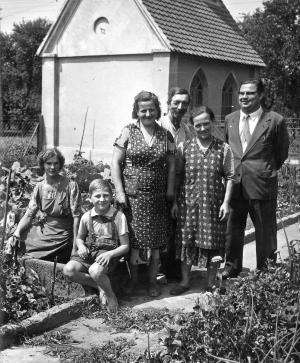Balance as the key to family farm survival

Family farms survived in the second half of the 20th century by balancing the demands of the regulated market economy with the astute use of their own resources. This is the conclusion reached by a research team working on an FWF project that examined agricultural development in Lower Austria during this period. The findings, which have recently been published in a scientific journal, clearly show that agrarian structural change in post-war Austria took a different course than was frequently assumed – instead of "getting big or getting out", many farming families exploited the advantages offered by self-controlled resources, adapted to change and survived.
"Get big or get out" was the mantra coined by an US minister of agriculture in the 1950s in response to the seemingly unavoidable expansion of farms in industrialised countries. It was believed that large-scale operations alone could accommodate the level of productivity required for farms to survive in an industrialised world. However, within the framework of a research project funded by the Austrian Science Fund FWF, a team from the Institute of Rural History has shown that this was not the only possible response to post-war agrarian structural change.
Hedging not betting the farm
Although international statistics indicate a concentration of land ownership in the decades following the Second World War, the reduction in farm numbers in Austria was limited and accompanied by a merely moderate growth in average farm size. Numerous farms clearly managed to survive without having to "get big". How farmers in Lower Austria managed to do this, was investigated by project leader PD Ernst Langthaler and his team (Dr. Rita Garstenauer, Mag. Ulrich Schwarz and DI Sophie Tod) for the period between 1945 and 1985. The conclusions they reached call the standard models on structural change in agriculture into question. PD Langthaler explains: "Many farmers found room to manoeuvre between the extremes of 'getting big' and 'getting out'. They embraced the increasing mechanisation of agriculture without abandoning the advantages offered by diversification and a self-controlled resource base."
The researchers were able to identify criteria from a large number of farms that enabled the successful pursuit of such a mixed approach: relatively moderate capital expenditure compared to other farms, and the use of a wide variety of income opportunities. Examples of such farms include the "cereal growers" and "mixed-farming families", which engaged in highly varied livestock and tillage activities. The two groups did not in any way reject the progressive mechanisation of farming; however, the associated capital investments were completely manageable for the farms and families involved.
Balancing act
The key to the farms' survival, however, was the capacity to balance the demands of the upstream and downstream markets through the self-control of their resource base. While the acquisition of technologies and sale of farm products were influenced by market forces, it was possible, in part, to decouple the fulfilment of operational and family requirements from these forces. PD Langthaler explains: "Many strategies were used to reduce the dependence on external market forces and thus ensure the survival of the farm, even in economically difficult times: the flexible deployment of – in particular female – family members, the lowering of consumption standards, the willingness to pursue supplementary sources of income, and the use of local and regional networks." Furthermore, the avoidance of plant and animal diseases and damage to mechanical equipment through the necessary care and maintenance, manageable levels of borrowing, product diversity and direct marketing also played an important role here.
The comprehensive study by PD Langthaler and his team is based on three main elements: a discourse analysis of a popular farmers' journal, the analysis of farming systems using farm statistics from the Mank and Mödling regions, and the reconstruction of the farming styles of four family farms based on multigenerational interviews.
Overall, the published findings of this FWF project show that the widely predicted "death of the peasantry" either did not materialise as expected – or depends on how the term "peasant" is defined. For the cases studied by this project, at least, the shrewd balancing of market dependence and resource autonomy enables the survival of family farms, under difficult economic circumstances as well.
More information: Four essays in Historische Anthropologie 20 (2012) H. 3, 276-426.
Provided by Austrian Science Fund (FWF)


















